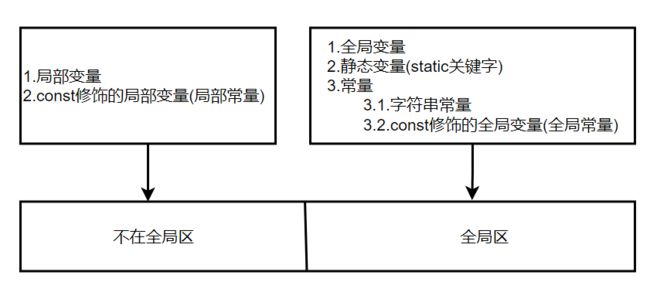C++编程学习(二) —— C++进阶编程
本阶段主要针对C++面向对象编程技术做详细讲解,探讨C++中的核心和精髓。
1 内存分区模型
C++程序在执行时,将内存大方向分为4个区域:
- 代码区:存放函数体的二进制代码,由操作系统进行管理;
- 全局区:存放全局变量和静态变量以及常量;
- 栈区:由编译器自动分配释放,存放函数的参数值,局部变量等;
- 堆区:由程序员分配和释放,若程序员不释放,程序结束时由操作系统回收。
在程序运行前有代码区和全局区,程序运行后才有栈区和堆区。
内存四区意义:
不同区域存放的数据,赋予不同的生命周期,给我们很大的灵活编程。
1.1 在程序运行前
在程序编译后,生成了exe可执行文件,未执行该程序前分为两个区域:
代码区:
存放CPU执行的机器指令;
代码区时==共享==的,共享的目的是对于频繁被执行的程序,只需要在内存中由一份代码即可;
代码区是==只读==的,使其只读的原因是防止程序意外地修改了它的指令。
全局区:
全局变量和静态变量存放在此;
全局区还包含了常量区,字符串常量和其他常量(也包括const修饰的变量)也存放在此;
该区域的数据在程序结束后由操作系统释放。
总结:
不在全局区中:局部变量、const修饰的局部变量
在全局区中:全局变量、静态变量(static关键字修饰的变量)、常量(字符串常量、
const修饰的全局变量(全局常量))
例如:
#include运行结果:
总结:
- C++中在程序运行前分为全局区和代码区;
- 代码区特点是共享和只读;
- 全局区中存放全局变量、静态变量、常量;
- 常量区存放
const修饰的全局变量(也称全局常量)和字符串常量。
1.2 程序运行后
栈区:
由编译器自动分配释放,存放函数的参数值,局部变量等。
注意事项:不要返回局部变量的地址,栈区开辟的数据由编译器自动释放。
错误示例:下面程序中返回局部变量的地址是错误的,栈区的数据运行后会自动释放。
#include堆区:
由程序员分配释放,若程序员不释放,程序结束时由操作系统回收
在C++中主要利用new在堆区开辟内存
示例:
#include总结:
堆区数据由程序员管理开辟和释放。
堆区数据利用new关键字进行开辟内存
1.3 new操作符
C++中利用new操作符在堆区开辟数据
堆区开辟的数据,由程序员手动开辟,手动释放,释放利用操作符delete
语法:new 数据类型
利用new创建的数据,会返回该数据对应的类型的指针。
示例:基本语法
#include2 引用
2.1 引用的基本操作
作用:给变量起别名
语法:数据类型 &别名 = 原名
示例:
#include2.2 引用注意事项
- 引用必须初始化
- 引用在初始化后,不可以改变
示例:
#include2.3 引用做函数参数
作用:函数传参时,可以利用引用的技术让形参修饰实参
优点:可以简化指针修改实参
示例:
#include总结:通过引用参数产生的效果同按地址传递是一样的。引用的语法更加清楚简单。
2.4 引用做函数返回值
作用:引用是可以作为函数的返回值存在的。
注意:不要返回局部变量引用
用法:函数调用作为左值
示例:
#include2.5 引用的本质
本质:引用的本质在C++内部实现是一个指针常量。
讲解示例:
#include总结:C++推荐用引用技术,因为语法方便,引用本质是指针常量,但是所有的指针操作编译器都帮我们做了。
2.6 常量引用
作用:常量引用主要用来修饰形参,防止误操作
在函数形参列表中,可以加const修饰形参,防止形参改变实参
示例1:
#include示例2:
#include3 函数提高
3.1 函数默认参数
在C++中,函数的形参列表中的形参是可以有默认值的。
语法:返回值类型 函数名 (参数 = 默认值) {}
示例:
#include总结:
- 如果函数实现中某个位置已经有了默认参数,那么从这个位置往后,从左到右都必须有默认值;
- 如果函数实现中已经定义了默认参数的值,如果主函数中如果调用这个函数,则用传过去的值进行函数运算;
- 如果函数的声明有默认参数,函数实现就不能有默认参数。函数声明和函数实现只能有一个有运行参数。
3.2 函数占位参数
C++中函数的形参列表里可以有占位参数,用来做占位,调用函数时必须填补该位置。
语法:返回值类型 函数名 (数据类型) {}
在现阶段函数的占位参数存在意义不大,但是后面的课程中会用到该技术。
示例:
#include3.3 函数重载
3.3.1 函数重载概述
作用:函数名可以相同,提高复用性
函数重载满足条件:
- 同一个作用域下
- 函数名称相同
- 函数参数类型不同或者个数不同或者顺序不同
注意:函数的返回值不可以作为函数重载的条件
示例:
#include3.3.2 函数重载注意事项
- 引用作为重载条件
- 函数重载碰到函数默认参数
示例:
#include4 类和对象
C++面向对象的三大特征:封装、继承、多态
C++认为万事万物都皆为对象,对象上有其属性和行为
例如:
人可以作为对象,属性有姓名、年龄、身高、体重…,行为有走、跑、跳、吃饭、唱歌…
车也可以作为对象,属性有轮胎、方向盘、车灯…,行为有载人、放音乐、放空调…
具有相同性质的对象,我们可以抽象成为类,人属于人类,车属于车类
4.1 封装
4.1.1 封装的意义
封装是C++面向对象三大特征之一
封装的意义:
- 将属性和行为作为一个整体,表现生活中的事物
- 将属性和行为加以权限控制
封装的意义一:
在设计类的时候,属性和行为写在一起,表现事物
语法:class 类名{ 访问权限: 属性 / 行为 }
示例1:设计一个圆类,求圆的周长
#include示例2:设计一个学生类,属性有姓名和学号,可以给姓名和学号赋值,可以显示学生的姓名和学号
#include封装的意义二:
类在设计时,可以把属性和行为放在不同的权限下,加以控制
访问权限有三种:
- public 公共权限
- protected 保护权限
- private 私有权限
示例:
#include总结:
- 公共权限 public 成员 类内可以访问 类外可以访问
- 保护权限 protected 成员 类内可以访问 类外不可以访问 在继承中,儿子也可以访问父亲中的保护内容
- 私有权限 private 成员 类内可以访问 类外不可以访问 在继承中,儿子无法访问父亲中的私有内容
4.1.2 struct和class区别
在C++中struct和class唯一的区别就在于默认的访问权限不同
区别:
- struct默认权限为公共
- class默认权限为私有
#include4.1.3 成员属性设置为私有
优点:
- 将所有成员属性设置为私有,可以自己控制读写权限
- 对于写权限,我们可以检测数据的有效性
示例:
#include练习案例1:设计立方体类
设计立方体类(Cube)
求出立方体的面积和体积
分别用全局函数和成员函数判断两个立方体是否相等
#include